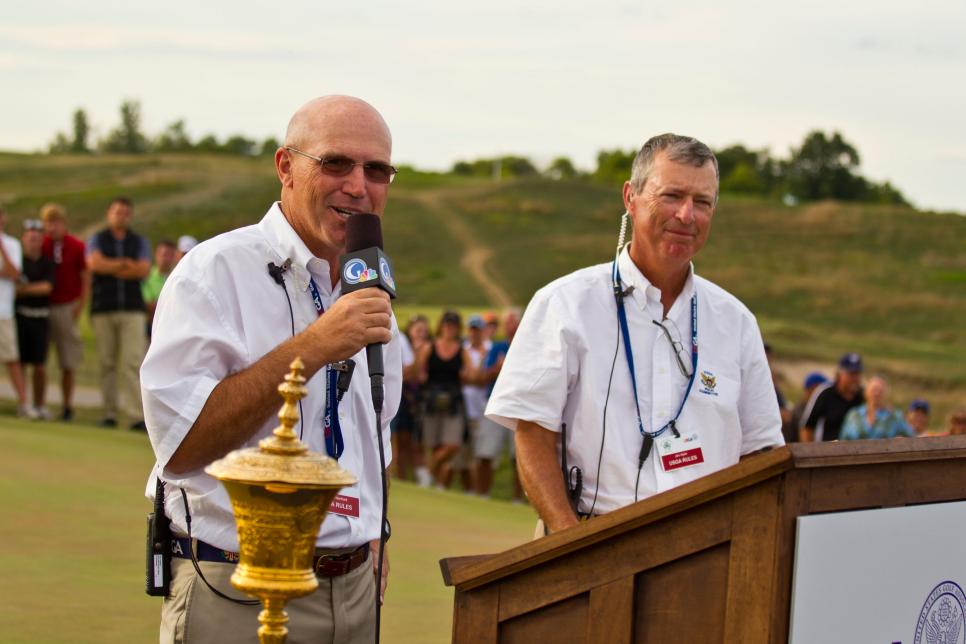Jim Reinhart was watching the final round of the 116th U.S. Open with family members in Wisconsin when his cellphone started lighting up “like a Roman candle.”
Reinhart (above left) was getting rings and pings because he’s general chairman of the 2017 U.S. Open at Erin Hills. He’s also a former USGA rules chairman who serves on the competition committee at Augusta National, and he’s a past member of the USGA’s executive committee.
The calls and texts were in regard to how his brethren at the USGA handled—or mishandled—the Dustin Johnson ruling. Reinhart admitted he was happier being at his sister’s house in the town of Mequon than facing the fallout at Oakmont.
“Friends of mine were very upset” said the 61-year-old founder and CEO of his eponymous institutional asset-management firm in Mequon, 35 miles from Erin Hills. “They just couldn’t believe it.”
Reinhart knows the kind of hot seat that USGA executive director Mike Davis shared last week with rules officials Jeff Hall and Thomas Pagel, senior managing director of rules John Bodenhamer and chairman of the USGA’s championship committee, Stuart Francis.
In 2013, Reinhart was in the scoring room at Augusta National reviewing video of Tiger Woods taking a bad drop during the second round of the Masters. Deliberation went into the night, and a decision wasn’t made until the following morning, with Woods receiving a two-stroke penalty but no disqualification for signing an incorrect scorecard.
“That was a case where everything happened after the fact,” Reinhart said. “There was lots of pressure. That was a very difficult situation. This one [the Johnson ruling] is a little bit different, but both are kind of unprecedented.”
In both cases, there was controversy and questioning of the rules process being administered through the lens of high-definition cameras. The blowback at Oakmont—reflected in the critical tweets from Rory McIlroy, Jordan Spieth and Woods—brought back age-old cries that the U.S. Open is “run by amateurs.”
“Mike Davis, Jeff Hall, Thomas Pagel, John Bodenhamer, the last thing they are is amateurs,” Reinhart said. “It doesn’t matter if it’s the PGA Tour, the R&A, the LPGA, these guys are professional golf administrators and nobody is better at it that I know.”
Reinhart naturally hopes Erin Hills won’t have to deal with the kind of negative narratives that have distracted from the competition at the last two U.S. Opens. At Chambers Bay, inconsistent putting surfaces drew sharp criticism from the players and came into play on Johnson’s three-putt par from short range on the 72nd hole. At Oakmont, some theorize that Johnson’s ball moved more because of the USGA’s on-the-edge course setup than anything else. Noting the combination of extreme Stimpmeter speed and slope on the fifth green, one respected caddie texted me with the message, “They were much more responsible for it than Dustin.”
Rather than the fescue of Chambers Bay or the Poa annua of Oakmont, the competitors at Erin Hills will be putting on A-4 Bentgrass greens. To ensure pristine condition, the greens will be shut down on Oct. 3 and not used again until practice rounds just before the championship the following June. Reinhart says the new greens putt much like the much-praised surfaces at Muirfield Village, which hosts the PGA Tour’s Memorial Tournament.
Not that the man who has been both a general chairman and rules chairman for the U.S. Open wants Erin Hills to be a putting contest. He just doesn’t want to see the national championship marred by another putting controversy.
Editor's Note: This story first appeared in the June 27 issue of Golf World.
